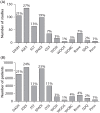Choosing patient-reported outcome measures for shoulder pathology
- PMID: 34667649
- PMCID: PMC8489482
- DOI: 10.1302/2058-5241.6.200109
Choosing patient-reported outcome measures for shoulder pathology
Abstract
This study was designed to identify the most frequent shoulder patient-reported outcome measures (PROMs) reported in high-quality literature.A systematic review was performed to identify shoulder PROMs, and their diffusion within the scientific literature was tested with a subsequent dedicated search in MEDLINE.506 studies were included in the final data analysis, for a total number of 36,553 patients.The Disabilities of the Arm, Shoulder and Hand questionnaire (DASH), the American Shoulder, Elbow Surgeons Score (ASES) and the Shoulder Pain and Disability Index (SPADI) were the most frequently reported PROMs in the analysed publications, with disease-specific PROMs being used with increasing frequency.A core set of outcome measures for future studies on patients with shoulder pathologies, based on the international acceptance and diffusion of each PROM, is needed.A combination of the DASH score for shoulder outcome assessment with more specific PROMs, such as the ASES for rotator cuff pathology and osteoarthritis and the SPADI for shoulder stiffness and shoulder pain of unspecified origin, is proposed as a recommended set of PROMs. Cite this article: EFORT Open Rev 2021;6:779-787. DOI: 10.1302/2058-5241.6.200109.
Keywords: outcome measures; patient-reported; shoulder.
© 2021 The author(s).
Conflict of interest statement
ICMJE Conflict of interest statement: The authors declare no conflict of interest relevant to this work.
Figures









References
-
- Mosher ZA, Ewing MA, Collins CS, et al. . Usage trends of patient-reported outcome measures in shoulder literature. J Am Acad Orthop Surg 2019;October:1. - PubMed
-
- Amadio PC. Outcomes measurements. J Bone Joint Surg [Am] 1993;75-A:1583–1584. - PubMed
-
- Dawson J, Carr A. Outcomes evaluation in orthopaedics. J Bone Joint Surg [Br] 2001;83-B:313–315. - PubMed
-
- Pynsent PB. Choosing an outcome measure. J Bone Joint Surg [Br] 2001;83-B:792–794. - PubMed
-
- Guillemin F, Bombardier C, Beaton D. Cross-cultural adaptation of health-related quality of life measures: literature review and proposed guidelines. J Clin Epidemiol 1993;46:1417–1432. - PubMed
Publication types
LinkOut - more resources
Full Text Sources
Medical

